[Versió catalana][Versión castellana]
Yolanda Maya Ortega
Director of Biblio TEC
Tecnológico de Monterrey
Summary
Libraries provide a stage for learning, creating and sharing experience; and both library services and the information professionals in charge of them are changing with the times, just as our educational systems are, offering us new ways to acquire knowledge.
The library at Tecnológico de Monterrey, Monterrey Campus, has evolved into Biblio TEC: a physical building that is at once an information reference service and a series of spaces designed to facilitate learning and interaction in study-related activities of different kinds.
With a surface area of some 17,000 sq. m., the building is divided into six levels of flexible spaces that can be adapted to the needs of individuals, teams and large groups of library users and that maximise the possibilities of private or group study and of learning in general.
On this new stage, the librarian’s role has also changed and librarians are no longer the keepers of services who decide what is to be used and how; instead, they have become information curators whose mission in this day and age is to facilitate the process by which patrons learn to acquire and use increasing amounts of information.
Resum
Les biblioteques són espais per aprendre, crear i compartir experiències, i així com els nostres models educatius es transformen per donar lloc a noves formes d’adquirir coneixement, les biblioteques i els professionals de la informació també ho estan fent.
La biblioteca del Tecnológico de Monterrey, Campus Monterrey, ha evolucionat a Biblio TEC, un edifici per consultar informació que, al seu torn, proporciona espais que faciliten l’aprenentatge i la interacció entre els usuaris i el desenvolupament d’activitats estudiantils.
Amb 17.000 metres quadrats de construcció, l’edifici està conformat per sis nivells amb una configuració d’espais flexibles que s’adapten a les necessitats d’individus, equips i grans grups de persones, en els quals es maximitzen les alternatives d’estudi, col·laboració i aprenentatge.
El paper del bibliotecari en aquest nou escenari es transforma també, ja que el seu rol ja no és el de ser amo de l’espai ni el de decidir com usar-lo. La seva participació s’enfoca com a curador de la informació i facilitador en el desenvolupament de les habilitats per accedir i usar la informació dels usuaris, tasca que cobra rellevància, sens dubte, en una època amb una gran generació d’informació.
Resumen
Las bibliotecas son espacios para aprender, crear y compartir experiencias, y así como nuestros modelos educativos se transforman para dar lugar a nuevas formas de adquirir conocimiento, las bibliotecas y los profesionales de la información lo están haciendo también.
La biblioteca del Tecnológico de Monterrey, Campus Monterrey, ha evolucionado a Biblio TEC, un edificio para la consulta de información que, a su vez, proporciona espacios que facilitan el aprendizaje y la interacción entre los usuarios y la realización de actividades estudiantiles.
Con 17.000 metros cuadrados de construcción, el edificio está conformado por 6 niveles con una configuración de espacios flexibles que se adaptan a las necesidades de individuos, equipos y grandes grupos de personas, donde se maximizan las alternativas de estudio, colaboración y aprendizaje.
El papel del bibliotecario en este nuevo escenario se transforma también, pues su rol ya no es el de ser dueño del espacio ni el de decidir cómo usarlo; su participación se enfoca como curador de la información y facilitador en el desarrollo de las habilidades para el acceso y uso de la información de los usuarios, labor que cobra relevancia, sin duda, en una época con una gran generación de información.
1 Introduction
Libraries provide a stage for learning, creating and sharing experience; and both library services and the information professionals in charge of them are changing with the times, just as our educational systems are, offering new ways to acquire knowledge.
In this vein, the library at Tecnológico de Monterrey, Monterrey Campus, has evolved into Biblio TEC: a physical building that offers not only an information reference service but also a series of spaces designed to facilitate learning and interaction in study-related activities of various kinds.
Biblio TEC features flexible spaces known as Learning Commons to promote research and foster creativity, collaboration and a sense of community. The implementation of these spaces has already been a success at Biblio TEC for some years. While the library remains at the centre of the academic community, one of the challenges now is to achieve greater virtual collaboration (e.g., online reading groups, links to online information resources, and participation in social networks with other libraries) in order to increase the involvement of users in the exchange of ideas and knowledge, not only locally but globally.
As for the use of technology, the key change lies in the shift of focus from collecting to connecting. The amount of information to which we now have access is unimaginably vast and no library can accommodate all the content that an academic community may need. As a result, librarians must ensure that their collections reach well beyond paper-based acquisitions to encompass subscriptions for digital content too. Collaboration networks among libraries will be crucial to ensuring access to pertinent content of all kinds.
In this brave new world of content, the librarian plays an indispensable role not only as a curator of information, but also as a guide and facilitator who helps users acquire the skills to locate, evaluate and analyse information and thereby fosters the development of their critical thinking and digital citizenship.
Library services can be accessed through automated systems such as self-checkout stations, radio frequency identification technologies and online catalogues, to name but a few examples. As for content, the opportunity is to evolve toward a digital world of search engines and browsers that reduce search times and simplify access. In all of the above cases, the role of the information professional is to design new interactions to enhance the library experience of users.
2 Transformation of the library
In 2015, the transformation of the library was launched in a public announcement. The overall purpose of the space was then jointly selected and refined in an interesting participative design process that drew on the involvement of over 1,100 students, teachers and other staff, together with various committees, teams and representatives engaged in the project. The work format of these multiple interconnected teams involved over 150 interactive work sessions as well as presentations to align opportunities and needs in the face of the new educational challenges that confront Tecnológico de Monterrey.
As technology advances by leaps and bounds, the library’s spaces need to evolve into knowledge centres that enable patrons to engage in multidisciplinary collaboration in order to formulate the questions of our times. And that is not all: the spaces must also serve to promote and encourage the search for answers to those questions in order to help in the building of a better today and tomorrow.
With these aims in mind, the library at Tecnológico de Monterrey, Monterrey Campus, opened a new building in 2017. Called Biblio TEC, it came as a response to the new educational model TEC21 and it exemplifies the central pillars of the new model: flexibility, connectivity and inspiration.
The architectural design, which is the work of Sasaki Associates Inc., GLR Arquitectos, RDLP Arquitectos y Convirtus, creates greater interaction between the building’s interior and exterior.
With a surface area of some 17,000 sq. m., the building is divided into six floors of flexible spaces that can be adapted to meet the needs of individuals, teams and large groups of library users. The aim is to maximise the opportunities for private and group study and for learning more generally.
The building has a maximum capacity of 2,500 people. During its first semester of usage, the number of recorded visits came to 1,902,500. The library is open 24 hours a day, 7 days a week, 365 days a year.
Biblio TEC provides traditional library services, such as lending material and help in the search for information. Its success, however, is due to its transformation of the concept of library usage. Biblio TEC takes full advantage of natural lighting, its furnishings are both comfortable and functional, and its users can take control of spaces to create their own experience in line with their particular needs.
The building’s main entrance hall is big enough to serve as an open auditorium for 150 people, hosting daily events of interest for the entire university community.
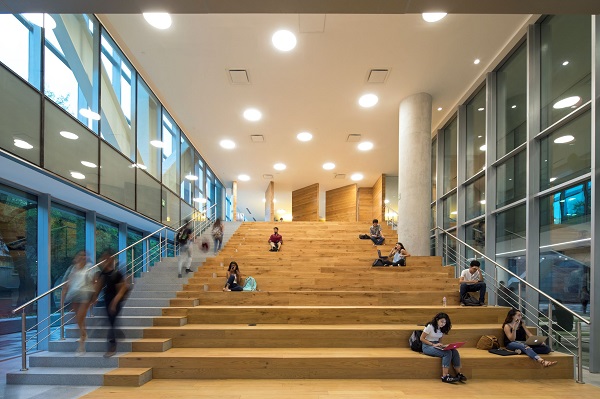
Photograph 1. Auditorium. Source: Tecnológico de Monterrey
Because of the wide variety of furnishings, students can engage in teamwork in spaces called Learning Commons, using accessories and tools that facilitate collaboration.
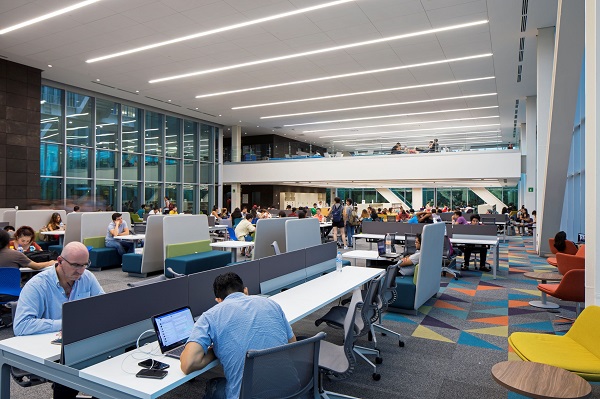
Photograph 2. Learning Commons. Source: Tecnológico de Monterrey
The entrance area on level 2 is home to library reference services, where staff provide help in the search for information and give advice on the use of digital resources. Over the course of an academic semester, the staff chalk up approximately 2,600 individual references provided.
On the same floor, the library also has multi-purpose rooms for instruction on bibliographical resources, seminars and other academic activities.
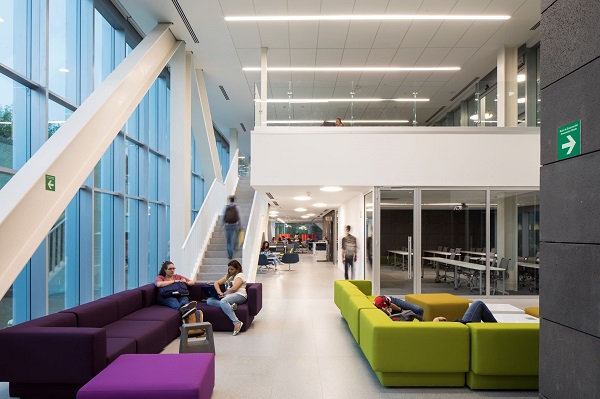
Photograph 3. Level 2. Source: Tecnológico de Monterrey
The printed collections are stored on different floors of the central stacks to facilitate access and consultation, while the furnishings are clustered in the outer areas to create a comfortable setting for study.
All materials have radio frequency identification tags affixed to them to improve the logistics of location and inventory.
The circulation service has been automated with a station for self-checkout, returns and renewals that is available for use 24 hours a day.
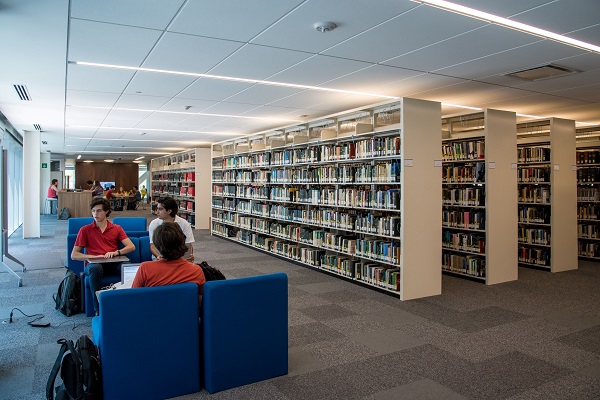
Photograph 4. Level 3. Source: Tecnológico de Monterrey
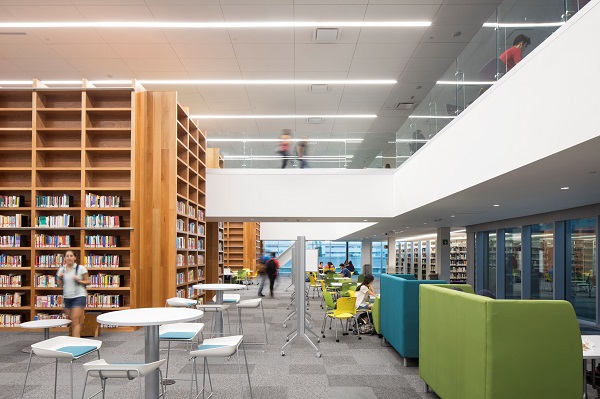
Photograph 5. Level 4. Source: Tecnológico de Monterrey
The open-air terrace on the fifth floor is one of the favourite spots of library patrons because of its breath-taking views of the mountains above Monterrey and because it has a café to add to the pleasure of the moment.
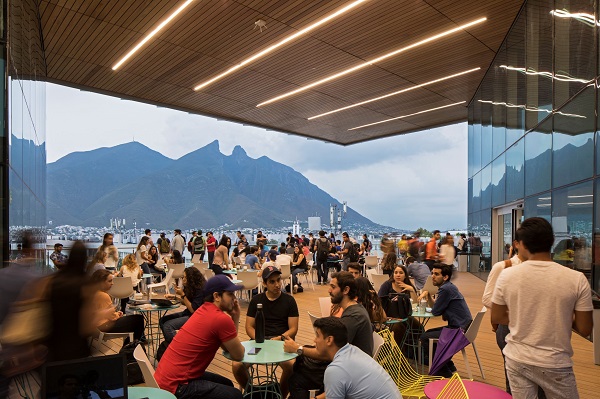
Photograph 6. Level 5, open-air terrace. Source: Tecnológico de Monterrey
Biblio TEC features spectacular overhangs of 9 and 18 meters that extend from the columns that support the building, while also meeting the strictest standards of quality and sustainability. As a result, Biblio TEC is a genuine feat of engineering.
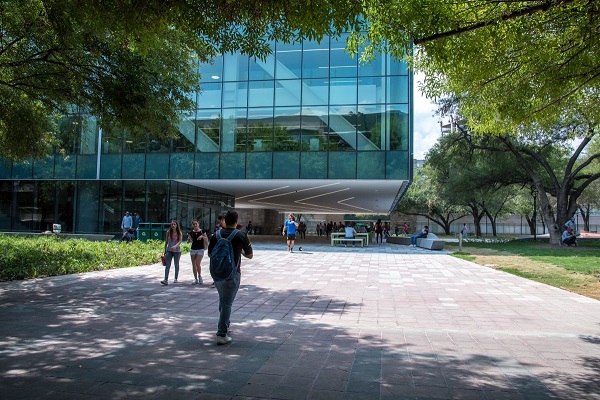
Photograph 7. External view. Source: Tecnológico de Monterrey
Walking the hallways, visiting the floors and climbing the stairways give patrons and visitors alike an experience full of surprises.
The central passage promotes connection and meeting, enabling visitors to reach the various points of interest on campus.
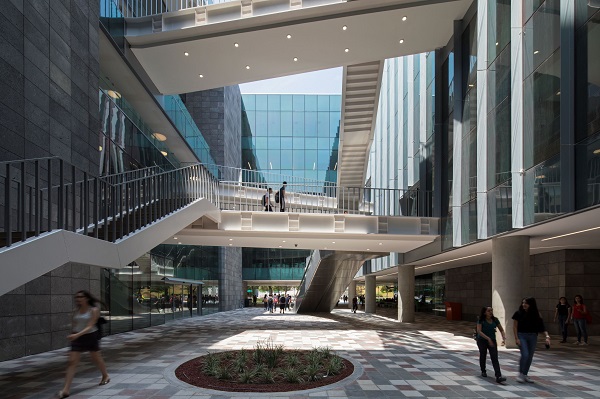
Photograph 8. Central courtyard. Source: Tecnológico de Monterrey
3 Challenges and indicators of usage
Administering the building comes with a number of challenges and issues, starting with its increased size: the old library had a total built area of 12,000 sq. m., whereas the new library features a total built area of 17,000 sq. m. out of which 9,700 sq. m. are designated for library services, stacks and study broken down as follows: 2,400 sq. m. for collaborative study in Learning Commons, 1,800 sq. m. for informal reading spots, 1,000 sq. m. for individual study spaces, 2,000 sq. m. for a creative area dedicated to the use of virtual reality resources, 1,500 sq. m. of stacks, 900 sq. m. for presentations and informal exhibitions and 100 sq. m. of working space to provide circulation and reference services.
The daily entrance figure is approximately 9,000 people. The occupancy rate climbs to 90 % at around ten a.m. and falls to 40 % by six p.m.
The monthly average for the number of entrances per user climbs to 17 visits during periods of greatest academic activity. In general, this reflects an increase of 65 % over the number of visits to the old library.
As for circulation, the library’s holdings were moved from closed stacks, where they had been safeguarded for two years, onto shelving in open spaces near study areas, leading to an increase of 5 % in use during the first semester. Thanks to the library’s radio frequency reader, it is also possible to determine onsite use, measuring how many books and which books are being used on library premises. Over a year, the monthly figure for onsite use is 5 % of the library’s total holdings.
The library has a staff of twenty people, including management, shift coordinators, reference librarians, and personnel who work directly with users, on reshelving or in the administration of collections.
The paradigm shift in the library’s usage model has been an issue of paramount importance. Some staff members have worked at the library for as many as forty years and have witnessed changes in function, the implementation of new technologies, new work methodologies, changes in the management team and much else. The institution has a reputation for being innovative and transformative, so the staff were already accustomed to change and had a heightened sensitivity to the need for change. The process of adaptation has been a gradual matter, backed by the institution’s leaders and undertaken with a strong user-focused approach, which is one of the team’s hallmarks.
4 Honours and distinctions
In 2018, Biblio TEC was recognised as the best academic library in the world in the over 30,000 sq. ft. category at the Library Interior Design Awards, which are given biennially by the International Interior Design Association and the American Library Association.
The project was also LEED Gold certified in the new construction category in July 2018 after passing a strict set of items that encompass best practices in building with regional or recycled materials and the installation of efficient energy, water and air-conditioning systems.
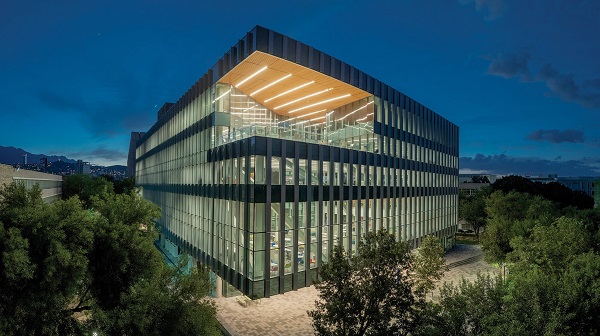
Photograph 9. View at night. Source: Tecnológico de Monterrey
On the first anniversary of the library’s opening, a questionnaire was administered to users to gauge their perception of the design of the space and its usage. One item asked students whether they found there to be a suitable atmosphere for studying in the library and 70 % of the respondents answered yes. This is a very positive result, showing that the aim of being a place for studying has been maintained.
5 Future
Introducing changes into the library’s spaces also opens the way to new forms of interacting with users, new services such as an area to consume virtual reality content, and new changes in the dynamics between librarians and users.
On this new stage, the librarian’s role has also changed. Librarians are no longer the keepers of services who decide what is to be used and how; instead, they have become information curators whose mission in this day and age is to facilitate the process by which patrons learn to gain access to and use information. These efforts will only grow in importance at a time when vast amounts of information are now being generated.
As anyone who has seen the transformation at first hand can attest, Biblio TEC at the Tecnológico de Monterrey, Monterrey Campus, clearly stands as a new milestone in the history of the world’s libraries.

 Creative Commons licence (
Creative Commons licence (